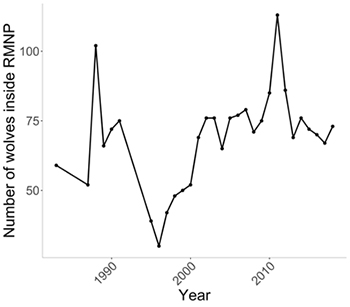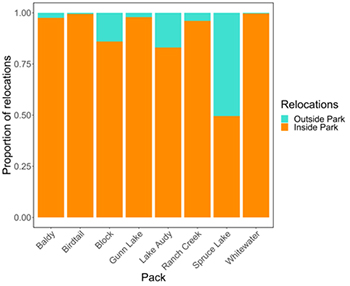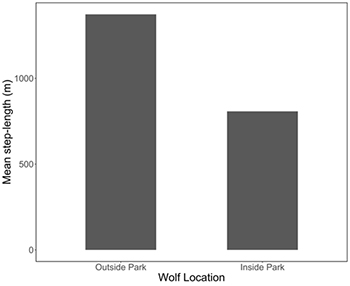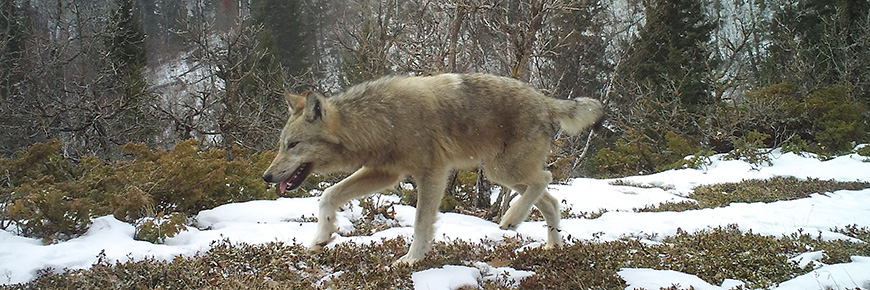
Wolves
Riding Mountain National Park
Wolves of Riding Mountain National Park
What is the role of wolves (in general)?
Wolves are top predators called apex predators, meaning they hunt and consume other animals but have no natural predators themselves, except humans.
When apex predators are removed there are impacts on the lower levels of the food chain. Apex predators are important for many reasons, one reason is that they control populations of medium-sized predators (called mesopredators) such as coyotes, raccoons or skunks. Populations of mesopredators can increase when apex predators are removed and this can have detrimental effects on the ecosystem and food chain (Ripple et al. 2014).
Wolves target vulnerable animals because they are easier to kill. Disease makes prey more vulnerable to predation, thus wolves can control disease levels in prey populations (Stronen et al. 2007).
Why do we study wolves in Riding Mountain National Park?
Wolves are keystone species in their ecosystems. Studying wolves gives us an appreciation and understanding of the dynamics occurring in prey and competitor populations.
Riding Mountain is unique and exemplary with a long and rich history of research on wolves dating all the way back to 1949. Since then there have been eight research projects conducted on wolves in the park. The most recent research on wolves was conducted from 2016-2018 by Christina Prokopenko and Sana Zabihi-Seissan.

How do we study wolves in RMNP?
With advances in tracking and monitoring technology there are many ways to study and understand wildlife, including wolves. Annual surveys, the use of very high frequency (VHF) collars and global positioning system (GPS) collars, site investigations, and trail cameras are all used to study wolves in RMNP.
Annual surveys
Every year we complete a wolf survey in late February using fixed wing aircraft. Snow track surveys are completed in the park annually during the winter to get an estimate of population size and pack size.

Aerial surveys are done using airplanes or helicopters each winter to estimate ungulate (elk and moose) population size and density. These surveys are critical in measuring the prey available to wolves and the changes that occur over time. In addition, observations of wolves are recorded during these surveys.
VHF (Very High Frequency) collars
VHF collars transmit a unique signal that is picked up using a special antenna or receiver. VHF collars can be tracked on the ground or by air. Aerial observations provide information on group size, behaviour, and location of wildlife.
Below is a map from VHF collars used in a 2003-2005 study by Stronen.
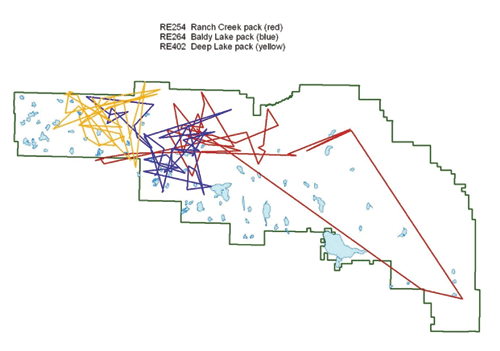
GPS (Global Positioning System) collars
The most recent research project completed by Prokopenko and Zabihi-Seissan used GPS collars. 13 wolves in five packs in 2016 and 14 wolves in six packs in 2017 were collared with GPS collars. These collars communicate with satellites and the locations can then be downloaded remotely by the researchers. In addition, these collars transmit VHF signals for aerial and ground tracking in real time. These data provide understanding of wolf behaviour, movements, diet, and mortality causes. If a collar has not moved from a location for eight hours, a mortality signal will be sent to the researchers and the VHF signal will change.
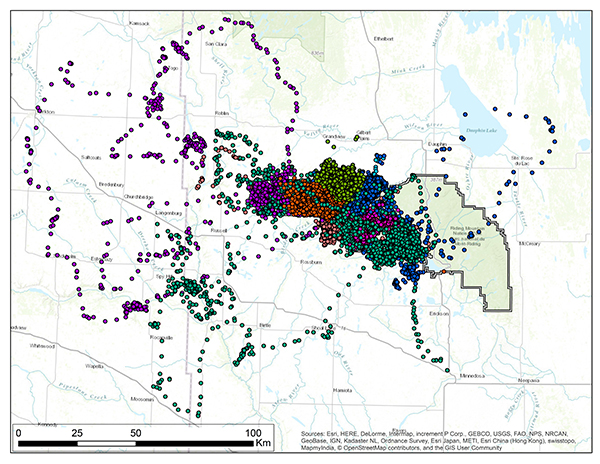
Site investigations
Wolf tracking and site investigations have occurred in the park at different periods over the past 50 years. Earlier studies used VHF and snow tracking to find kill sites. The most recent wolf project used the GPS data from wolves to direct the fieldwork.
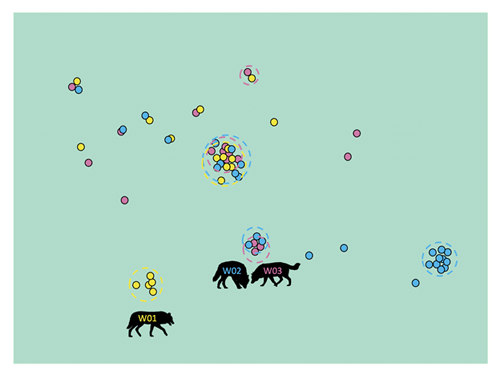
Areas of use (indicated by ‘clusters’ of locations in a specific site) were investigated to determine wolf behaviour. At the site, scat was collected to provide a complete picture of wolf diet and to compare results to previous winter scat collection research (Sallows 2007).
If a kill was found at the site, researchers collected hair, marrow, and a tooth (front incisor) for genetic testing, prey condition, and aging.
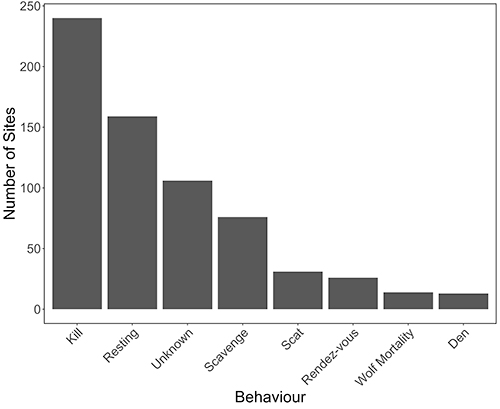
Genetics
Hair and tissue samples are collected when wolves are collared. These samples can be used to find out relatedness between wolves both within the park and compared to DNA collected from animals living in different areas (Stronen et al. 2010).
For the current wolf research, wolf hair and tissue samples have been collected for each collared animal (25) and during site investigations.
Trail Cameras: Capturing the hidden lives of animals
Trail cameras capture some exciting and unique moments that can be appreciated by any nature lover.
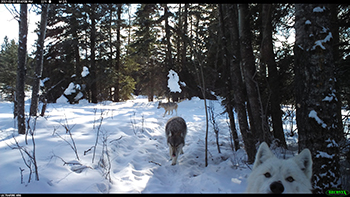
Trail cameras are also becoming an important tool for science and research. Cameras can provide information on many species, including wolves.
Trail cameras can be used to monitor the population sizes of wildlife in Riding Mountain National Park, local densities, and group sizes across different areas of the park. Pictures can tell us more than just numbers, we can learn about the animals that make up a population including the number of pups per year and the health of individuals (visible disease, body condition).
Images can also be used to identify different behaviours and the habitat that supports animals. Instead of being limited to single snapshots of population size and composition, which traditional snow and aerial surveys are, trail cameras provide constant monitoring 24 hours a day, year-round.
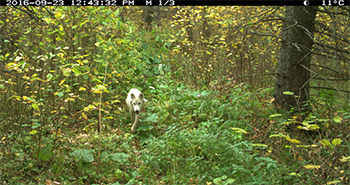
Trail camera projects are a non-invasive way to study wildlife in the park and it provides an opportunity for community and citizen involvement in research.
What is the reproductive behaviour of wolves?
Wolves breed in the mid-winter (February) and will den in the spring (late April-May). Wolves can have 5-7 pups each year but the survival rates of pups in the first few months are low, like other wildlife young.
When pups become more mobile they leave the den area for rendezvous sites. Adults share the pup rearing duties and will bring food back to den and rendezvous sites. Researchers visit these sites after pups and adults have left the area to collect scat and document bones left from what adults have brought back. Beaver are a predominant prey brought to these sites.
How do wolves die?
The mortality rate of the 25 collared wolves during the study was 68% (a conservative estimate due to collars dropping off early, preventing confirmation of yearly survival in those individuals). There is a mortality risk to wolves when they are outside the park, five wolves out of the 17 mortalities were related to the influence of human beings on nature. Three mortalities were due to aggressive interactions between wolves.
The most common cause of death in the sample population was Canine Distemper Virus (CDV). Two packs in 2016, and two packs in 2017 had multiple mortalities (both collared adults and pups found at sites) due to CDV. In a study completed between 2003-05, eight of 18 blood samples indicated exposure to CDV with one wolf death attributed to this disease (Stronen et al. 2011). The most recent study indicates a total of 11 CDV deaths. While CDV is not newly present in RMNP’s wolf population, the mortality due to disease appears to be greater in this study compared to previous studies.
What is the range size of wolves in RMNP?
The average home range size of the packs while they were stable was 203 km2 which is much smaller than the average wolf home range size compared to packs elsewhere. Pack home ranges overlapped with each other and on a few occasions packs did scavenge on kills of neighbouring packs. On a handful of occasions packs were found to be at the same location simultaneously. Their home ranges seemed restricted by the park boundary with the core ranges being consistently within the park.
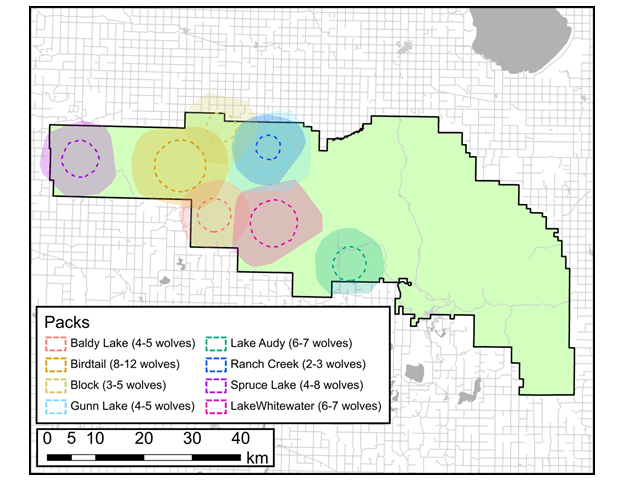
What do wolves eat?
Wolves are carnivores and they eat a variety of prey types. During the most recent wolf study, 242 investigated sites were confirmed to be kill sites. Kill site investigations revealed that wolves killed mostly moose (43.7%). Other prey items included white-tailed deer (22.4%), elk (19.2%) and beaver (9.4%).
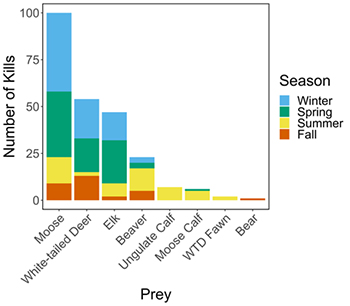
Beaver and ungulate calves were killed when they were seasonally available (although wolves did kill beavers opportunistically in winter), while adult ungulates (deer, moose, and elk) were killed throughout the year.
Packs differed in their kill rates, but all packs were supported by a diverse prey base, with moose as the primary prey item for most packs, and notably elk were not the primary prey for any pack. Secondary prey varied between elk and white-tailed deer depending on the pack.
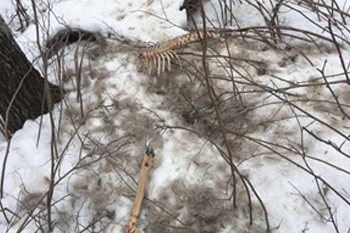
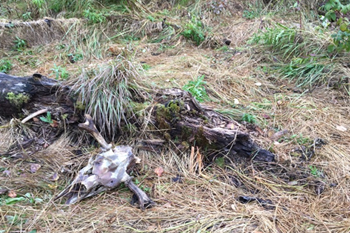
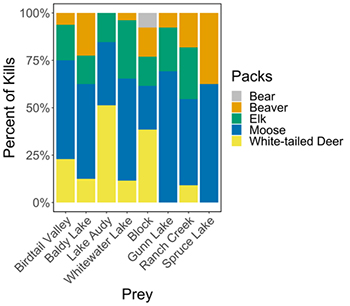
It is interesting to note that the Lake Audy pack killed the most deer out of the packs studied which is consistent with kill site investigations performed in 1978 (Carbyn 1983).
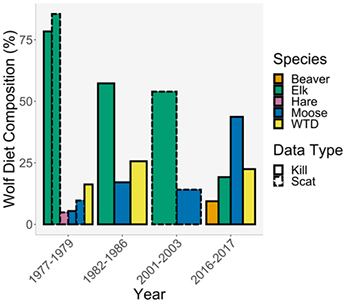
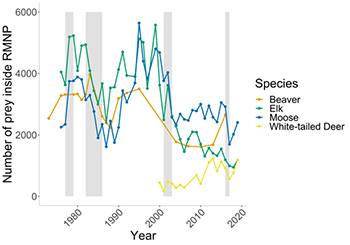
Past research suggests that wolves focused their hunting efforts on elk; kill site investigations occurred in 1978-79 and 1982-86, while scat analysis occurred in 1978-79 and 2001-03 (Carbyn 1983, Paquet 1992, Sallows 2007).
The most recent study is the first to identify moose as the dominant prey type for wolves in Riding Mountain National Park, likely in part due to changes in prey population densities in recent years.
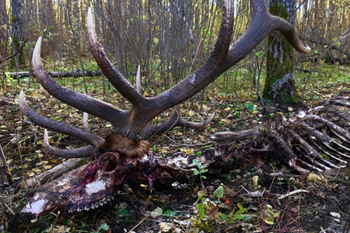
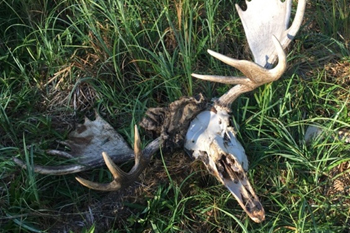
Are wolves responsible for the recent decline in elk populations in RMNP?
What are their impact on landowners?
The sample population of wolves collared in the park did not kill any livestock during the study. Manitoba Sustainable Development has a Problem Predator Management Program in agreement with the Manitoba Trappers Association. In 2014, there were 34 claims (the lowest number since the beginning of the program in 2007) for which 64 coyotes, 27 wolves, and 3 fox were removed. The areas outside of the park are not listed as chronic wolf depredation areas.
Can humans and wolves coexist?
Should visitors be concerned about their own safety or that of their pets when hiking or camping in RMNP?
No. Wolves will keep their distance from humans. Wolf-human conflicts occur from improper waste and attractant management or intentional feeding of animals. When wolves are given access to human food sources they become habituated to humans and learn they can get resources from them. There have been reports from other areas in North America of wolves attacking and killing free-roaming dogs. Therefore, for the safety of a pet, its owner, and wildlife, visitors are required to keep their pets on a leash at all times. If humans act considerately then co-existence with wolves, predators, and wildlife is very achievable.
When are wolves most active?
Wolves in the park and elsewhere move fastest during dawn and dusk. It is thought that wolves are active when their prey is most active to kill during those times. However, preliminary results from Prokopenko’s research show that the wolves in Riding Mountain National Park may not be following that same behaviour cycle of killing during twilight in the winter, and only somewhat in the summer.
What is the difference between wolves and coyotes?
Compared to wolves, coyotes have a smaller, narrower face with a pointier nose. Coyotes also have larger ears, relative to the size of their head. Coyotes have smaller bodies than wolves and have a reddish-grey coat. In general, wolf sightings are much rarer.
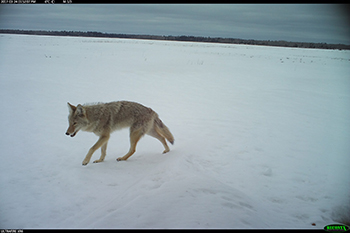
How do wolves hunt prey?
Wolves are intelligent and social hunters that change their space use and social behaviour to increase their successful capture of prey. Using the collar data, researchers found wolves track their primary prey (moose) in habitat and areas where they are more likely to catch them (Zabihi-Seissan 2018). In other words, wolves do not waste any time in areas were there is no prey.
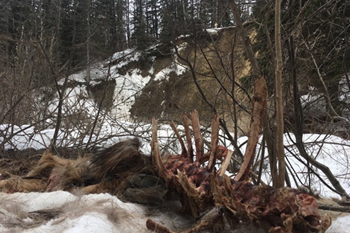
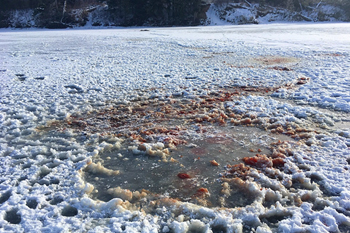
Do wolves always travel in packs?
While wolves have stable pack units, they can be dynamic, i.e. they sometimes are not with pack mates.
Different factors influence if wolves are with their pack mates, including their hunting strategy, season, and prey densities.
Zabihi-Seissan (2018) found that when wolves were hunting large prey, like moose, they were together but when they were hunting beaver they often did so alone. This is a good example of how wolves make behavioural decisions based on cooperating and subsequent sharing of food to maximize their energy intake. These results also demonstrate the importance of packs in successfully hunting large prey.

Where do you go for more information about RMNP wolves?
Stop by the Visitor Centre or Administration building, or call 204-848-7275 for more information.
Content provided by Christina Prokopenko for Parks Canada.
Christina Prokopenko is a PhD candidate and Vanier Scholar in the Wildlife Evolutionary Ecology Lab out of Memorial University of Newfoundland, but her heart and passion is in RMNP and Manitoba. Sana Zabihi-Seissan is a former WEEL member and MUN alumnus who completed his MSc studying the wolves of RMNP.
Sana and Christina would like to thank the individuals and organizations that made this work possible including Parks Canada, Manitoba Sustainable Development, the Fish and Wildlife Enhancement Fund, the Nature Conservancy of Canada.
Follow Christina on twitter @proko_eco and Instagram @wolvesofRMNP
Citations (RMNP research denoted with *)
*Banfield, A.W.F. 1949. An Irruption of Elk in Riding Mountain National Park, Manitoba. Journal of Wildlife Management. 13:127-134.
*Brook, R. K. 2007. Elk-Agriculture conflict in the greater Riding Mountain National Park ecosystem: Bulding Bridges between the Natural and the Social Science. University of Manitoba.
*Vander Wal, E. 2011. Sex, friends, and disease: social ecology of elk (Cervus elaphus) with implications of pathogen transmission. University of Saskatchewan.
*Carbyn, L. N. 1983. Wolf predation on elk in Riding Mountain National Park, Manitoba. Journal of Wildlife Management 47:963–976. Lennox, R. J., A. J. Gallagher, E. G. Ritchie, and S. J. Cooke. 2018. Evaluating the efficacy of predator removal in a conflict-prone world 224:277–289.
*Paquet, P. C. 1992. Prey use strategies of sympatric wolves and coyptes in Riding Mountain National Park, Manitoba. Journal of Mammalogy 73:337–343. Ripple, W. J., J. a Estes, R. L. Beschta, C. C. Wilmers, E. G. Ritchie, M. Hebblewhite, J. Berger, B. Elmhagen, M. Letnic, M. P. Nelson, O. J. Schmitz, D. W. Smith, A. D. Wallach, and A. J. Wirsing. 2014. Status and ecological effects of the world’s largest carnivores. Science (New York, N.Y.) 343:1241484.
*Prokopenko, C. PhD candidate and Vanier Scholar in the Wildlife Evolutionary Ecology Lab out of Memorial University of Newfoundland.
*Sallows, T. 2007. Diet preference and parasites of grey wolves in Riding Mountain National Park of Canada. Master of Environment:90. Santiago-avila, F. J., A. M. Cornman, and A. Treves. 2018. Killing wolves to prevent predation on livestock may protect one farm but harm neighbors:1–20. Stone, S. A., S. W. Breck, J. Timberlake, P. M. Haswell, F. Najera, B. S. Bean, and D. J. Thornhill. 2017. Adaptive use of nonlethal strategies for minimizing wolf – sheep conflict in Idaho 98:33–44.
*Stronen, A. V., R. K. Brook, P. C. Paquet, and S. Mclachlan. 2007. Farmer attitudes toward wolves: Implications for the role of predators in managing disease. Biological Conservation 135:1–10.
*Stronen, A. V., G. J. Forbes, T. Sallows, G. Goulet, M. Musiani, and P. C. Paquet. 2010. Wolf body mass, skull morphology, and mitochondrial DNA haplotypes in the Riding Mountain National Park region of Manitoba, Canada. Canadian Journal of Zoology 88:496–507.
*Stronen, A. V, T. Sallows, G. J. Forbes, B. Wagner, and P. C. Paquet. 2011. Diseases and parasites in wolves of the Riding Mountain National Park region, Manitoba, Canada. Journal of wildlife diseases 47:222–227.
Vander Vennen, L. M., B. R. Patterson, A. R. Rodgers, S. Moffatt, M. L. Anderson, and J. M. Fryxell. 2016. Diel movement patterns influence daily variation in wolf kill rates on moose. Functional Ecology:1568–1573.
Wielgus, R. B., and K. A. Peebles. 2014. Effects of Wolf Mortality on Livestock Depredations:1–16.
*Zabihi-Seissan, S. 2018. Gray wolves adjust their spatial and social environments according to prey distributions in a multi-prey system. Memorial University of Newfoundland.
- Date modified :
